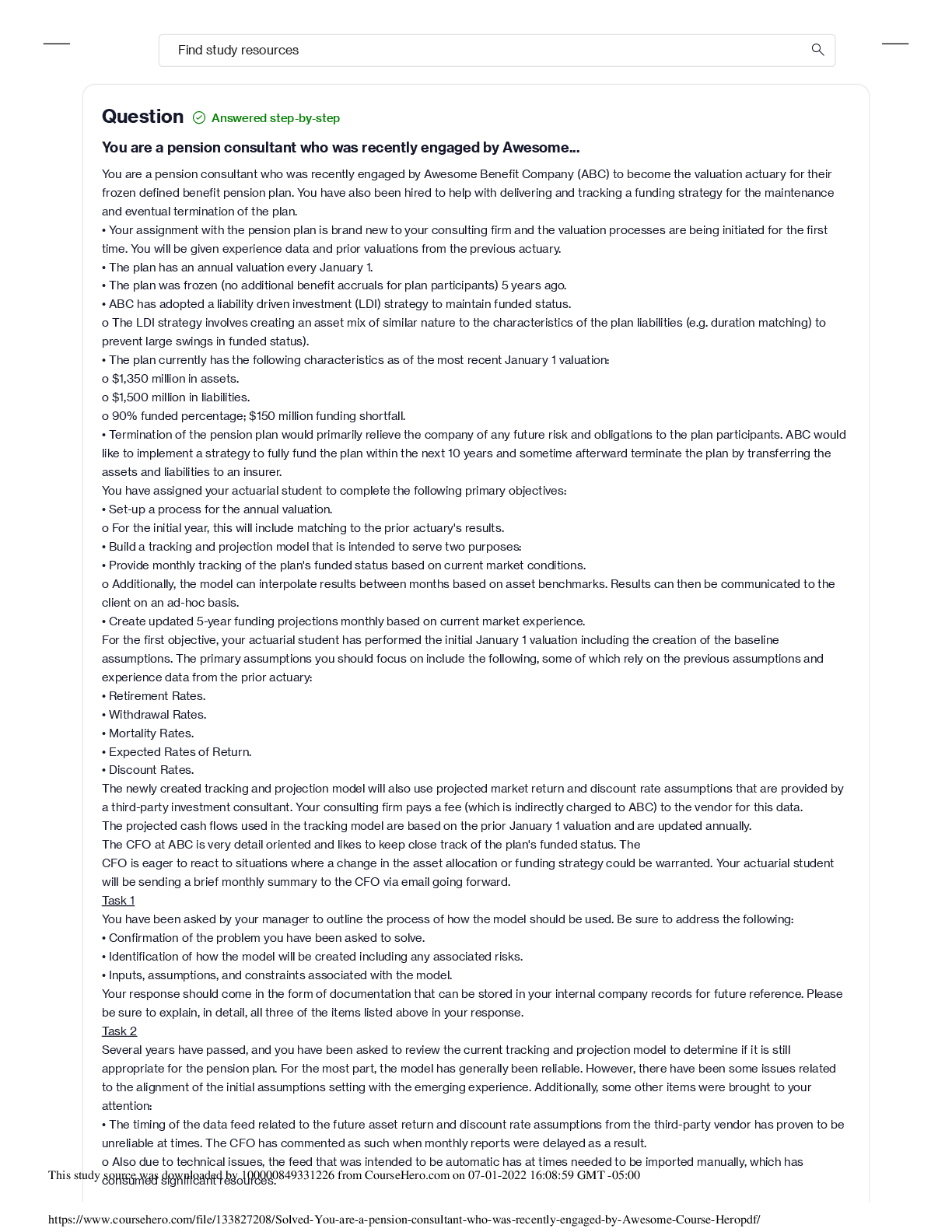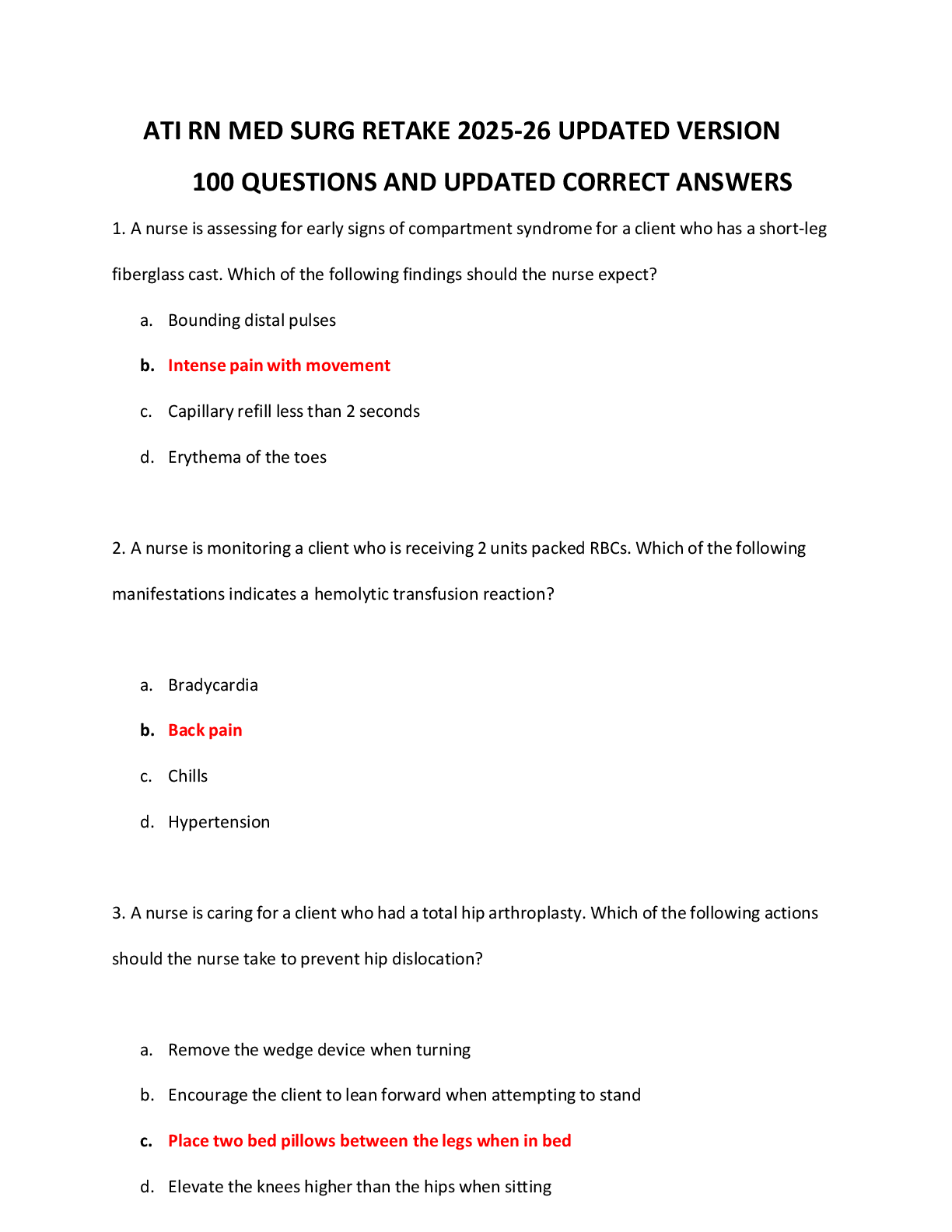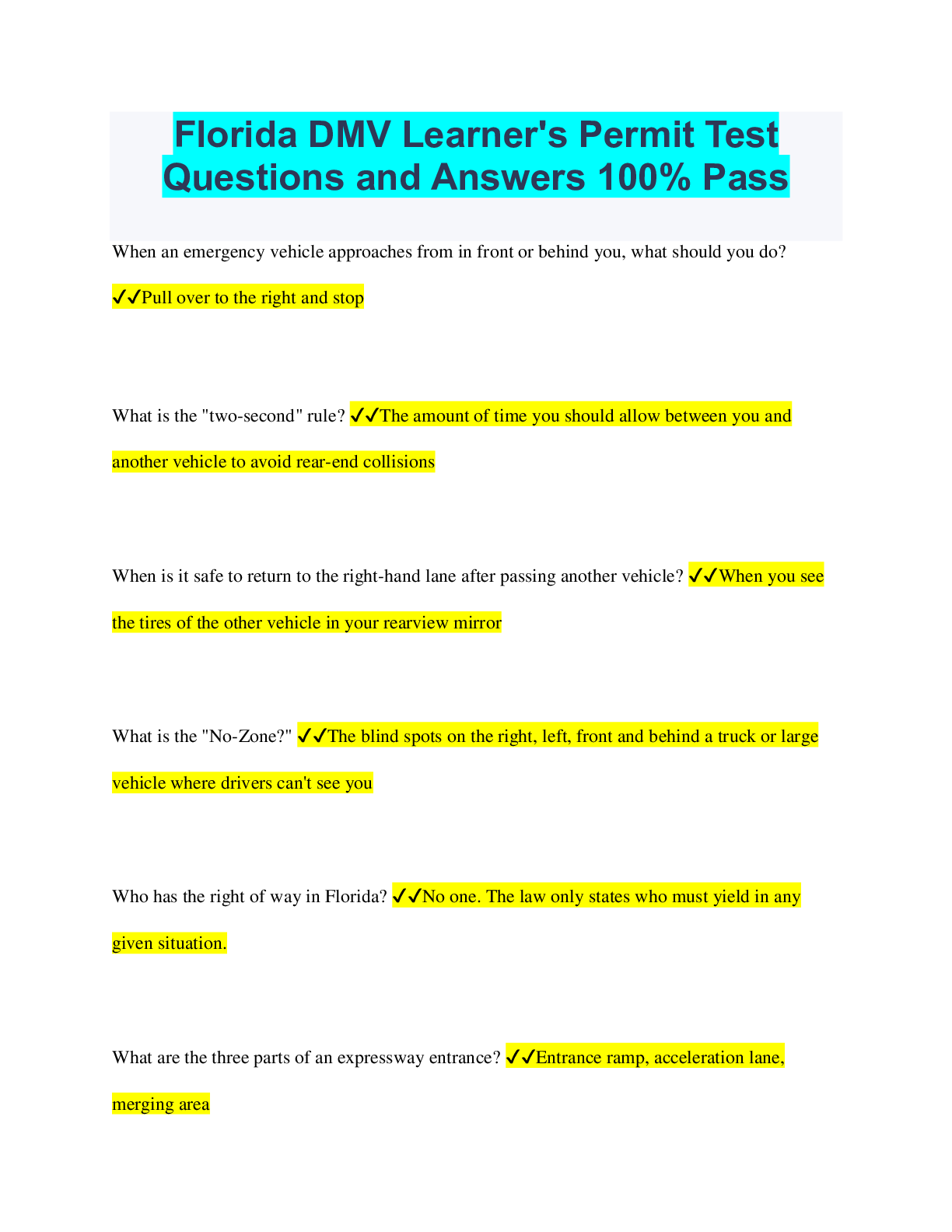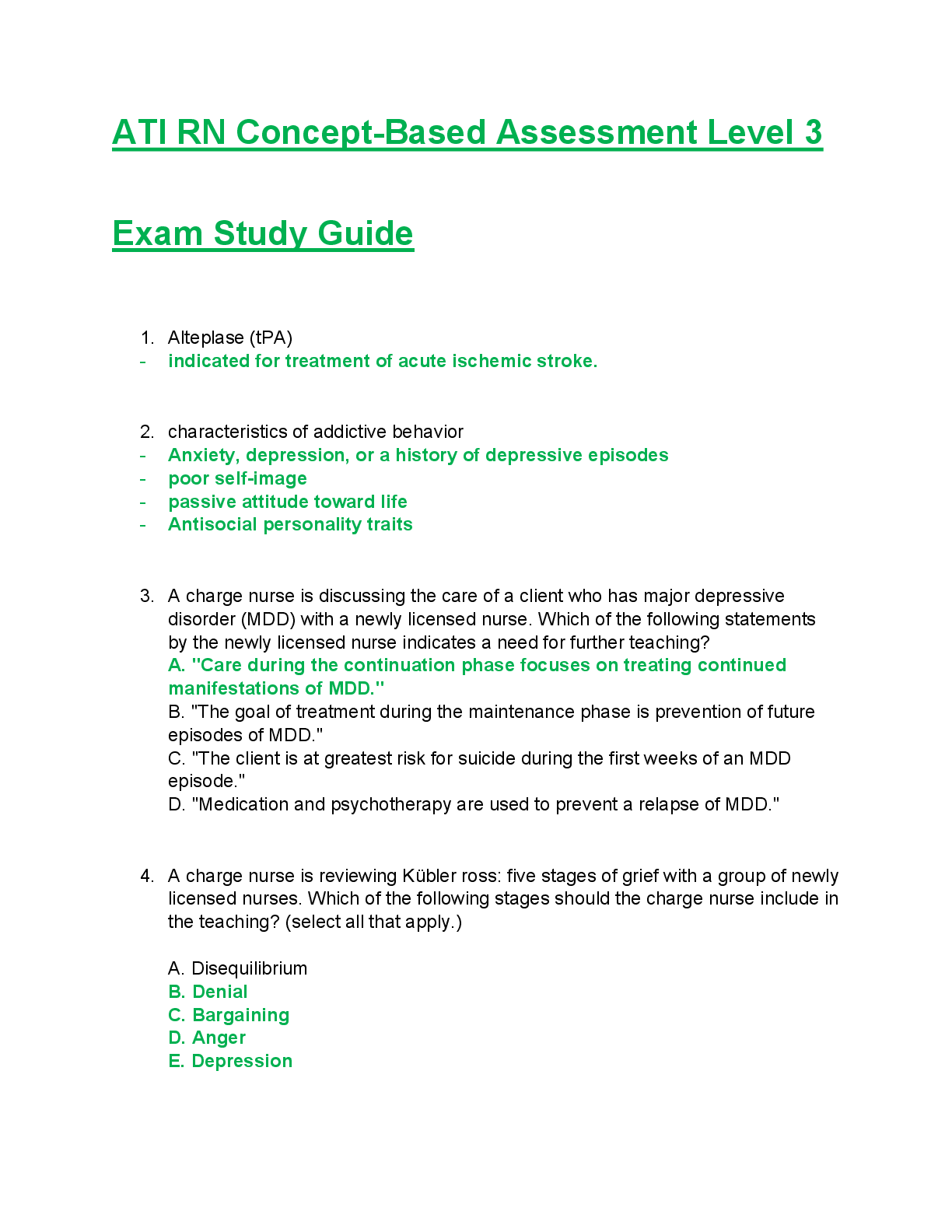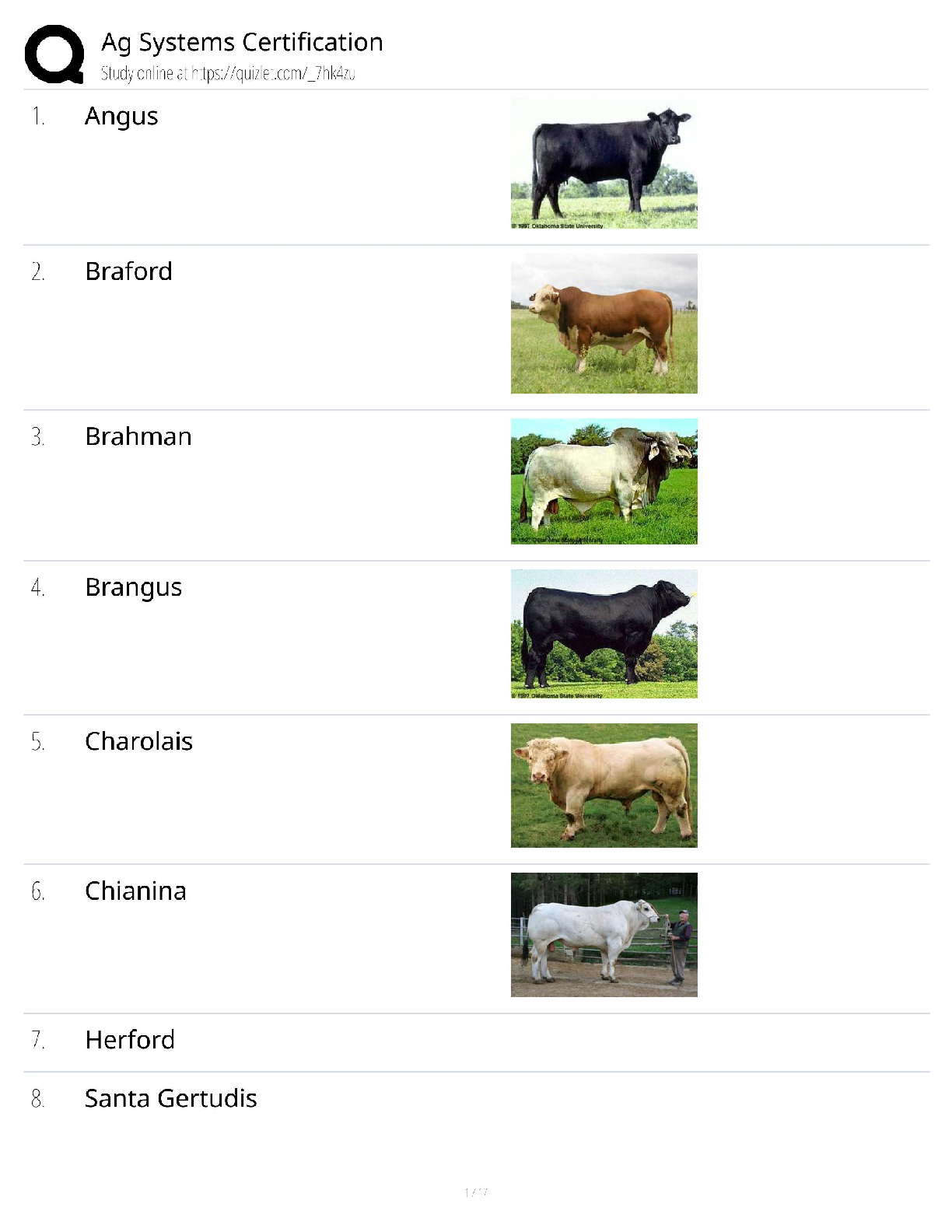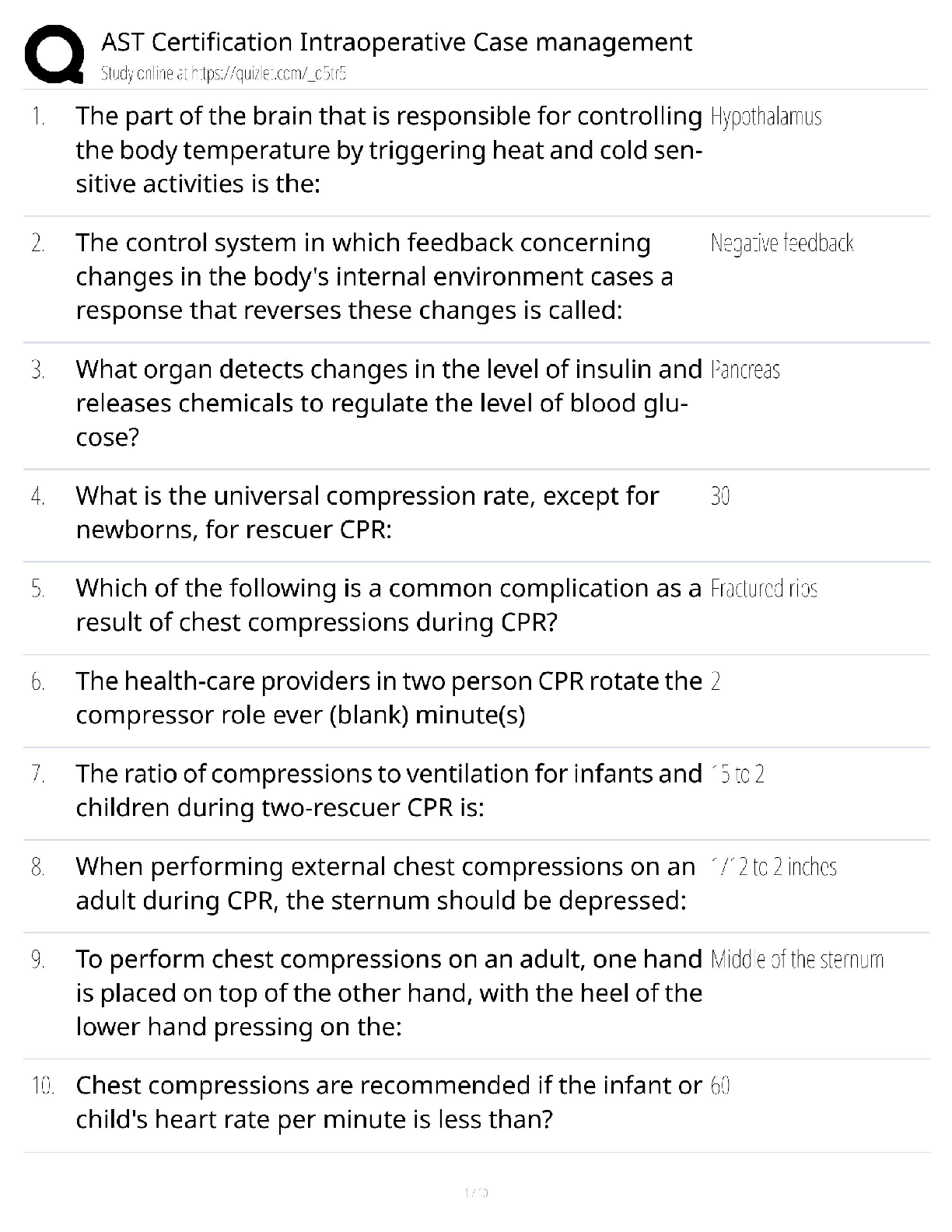Biology > QUESTIONS & ANSWERS > Chapter 2—Fundamentals of Ecology. Answers Explained (All)
Chapter 2—Fundamentals of Ecology. Answers Explained
Document Content and Description Below
MULTIPLE CHOICE 1. Ecology is: a. a type of life style. b. the study of the interaction of organisms and their environment. c. a place where organisms live. d. what happens when a predator con ... sumes a prey item. e. the study of the physical environment in an ecosystem. B PTS: 1 DIF: Recall REF: 15 2. The biosphere a. is located in the Northern Hemisphere. b. contains organisms with similar needs. c. has environmental conditions of similar temperature, pressure, and salinity. d. supports all of life on earth. e. is restricted to the continents. D PTS: 1 DIF: Recall REF: 15 3. Organisms that live under similar environmental conditions and location, and interact directly or indirectly are part of the same: a. ecosystem. b. biosystem. c. abiotic habitat. d. biotic habitat. e. population. A PTS: 1 DIF: Recall REF: 15 4. An example of abiotic factors influencing marine organisms is: a. predation. b. competition for food. c. parasitism. d. salinity. e. bacterial disease. D PTS: 1 DIF: Recall REF: 16 5. Habitat refers to where an organism: a. lives. b. feeds. c. reproduces. d. forages. e. All of the above. E PTS: 1 DIF: Synthesis REF: 16 6. The habitat of a species has a. both abiotic and biotic factors. b. neither biotic or abiotic factors. c. biotic factors. d. abiotic factors. A PTS: 1 DIF: Recall REF: 16 7. Habitat complexity can support a. complex life histories. b. increased biodiversity. c. higher productivity. d. more different species in an area. e. All of the above. E PTS: 1 DIF: Recall REF: 16 8. An environment would be considered harsh to an organism if: a. it would be difficult for the individual to maintain homeostasis. b. the temperatures are extreme. c. salinity varies. d. pressure gradients are large. e. light levels are low. A PTS: 1 DIF: Recall REF: 16 9. Regions above or below the optimal range of an environmental variable are called: a. zones of stress. b. tolerance zones. c. optimal range areas. d. None of the above. e. b and c only. A PTS: 1 DIF: Recall REF: 17 10. A population growth pattern that reaches a certain level is described with a(n) a. logarithmic equation. b. exponential equation. c. logistic equation. d. J -shaped curve. e. quadratic equation. C PTS: 1 DIF: Recall REF: 24 11. You start to culture a petri dish of marine bacteria. Each day, the number of visible colonies growing on the agar surface increases in this fashion: 2, 4, 16, 32, 64, 128. This growth pattern is best described as a. logarithmic. b. logistic. c. exponential. d. quadratic. C PTS: 1 DIF: Application REF: 24 12. The largest group and most important marine photosynthetic organisms are: a. kelp. b. seagrasses. c. macroalgae. d. phytoplankton. e. giant kelps. D PTS: 1 DIF: Recall REF: 17 13. Animals that obtain their body heat from internal metabolism are called: a. ectotherms. b. poikilotherms. c. endotherms. d. osmoconformers. e. osmoregulators. C PTS: 1 DIF: Recall REF: 18 14. An organism that maintains a constant body temperature is termed: a. an endotherm. b. an ectotherm. c. a poikiotherm. d. cold blooded. e. an osmoconformer. A PTS: 1 DIF: Recall REF: 18 15. An organism whose temperature is similar to its surroundings is called a(n) a. endotherm. b. poikiotherm. c. ectotherm. d. warm blooded organism. e. osmoregulator. C PTS: 1 DIF: Recall REF: 18 16. A particular sea bird has a Type 1 survival curve, and older female birds produce more eggs than younger birds. What is an evolutionary strategy of these birds? a. young birds reach maturity rapidly b. reproduction is delayed c. birds reach maturity slowly d. both a and b e. both b and c E PTS: 1 DIF: Application REF: 22–23 17. The amount of dissolved salts in water determines the: a. temperature. b. luminosity. c. salinity. d. clarity. e. turbidity. C PTS: 1 DIF: Recall REF: 18 18. The movement of water across a membrane in response to a gradient of solute concentration is called: a. salinity. b. osmosis. c. solubility. d. diffusion. e. pressure. B PTS: 1 DIF: Recall REF: 18 19. An atmosphere of pressure at sea level,, in psi (pounds per square inch), equals: a. 15. b. 14.7. c. 15.7 d. 16.5. e. 16.7 B PTS: 1 DIF: Recall REF: 19 20. The pressure of the oceans increases by one atmosphere for every ____ meter increase in depth. a. 5 b. 10 c. 15 d. 20 e. 25 B PTS: 1 DIF: Recall REF: 19 21. At what depth would water pressure be 4 times greater than atmospheric pressure at the surface? a. 10 meters b. 20 meters c. 30 meters d. 40 meters e. 50 meters D PTS: 1 DIF: Application REF: 19 22. In the carbon cycle, animals play a fundamental role by: a. decreasing the amount of dissolved carbon dioxide. b. increasing the amount of dissolved carbon dioxide as a result of respiration. c. increasing the amount of dissolved carbon dioxide as a result of photosynthesis. d. decreasing the amount of plant biomass. e. decreasing it as a result of photosynthesis. B PTS: 1 DIF: Recall REF: 36 23. An important inorganic nutrient needed by marine photosynthetic organisms is: a. glucose. b. amino acids. c. lipids. d. nitrates. e. carbohydrates. D PTS: 1 DIF: Recall REF: 36 24. Oxygen during the early development of the atmosphere was: a. common. b. rare. c. important for photosynthesis. d. about the same as now. e. created from the cooling of hot lava. B PTS: 1 DIF: Recall REF: 20 25. Those organisms that thrive in an environment free of oxygen are called a. phytoplankton. b. zooplankton. c. nekton. d. anaerobes. e. aerobic. D PTS: 1 DIF: Recall REF: 20 26. Anaerobic organisms thrive: a. in oxygen-free environments. b. where oxygen is abundant. c. where carbon dioxide is abundant. d. in surface waters of the ocean. e. in the middle of the water column. A PTS: 1 DIF: Recall REF: 20 27. Metabolic wastes are: a. the byproduct of metabolism. b. unused nutrients during metabolism. c. re-used by the organism. d. unimportant to community metabolism. A PTS: 1 DIF: Recall REF: 20 28. Waste products of metabolism tend to accumulate in: a. open ocean areas. b. coastal waters. c. small enclosed bodies of water. d. fast circulating water. e. major ocean currents. C PTS: 1 DIF: Recall REF: 20 29. When two different species require the same resources we may observe a. intraspecific competition. b. resource partitioning. c. interspecific competition. d. predation. e. symbiosis/parasitism. C PTS: 1 DIF: Recall REF: 20 30. ____ is when one organism successfully outcompetes another organism and excludes it from a particular area or niche. a. Predation b. Resource partitioning c. Parasitism d. Competitive exclusion e. Commensalism D PTS: 1 DIF: Recall REF: 27 31. The niche of the species is best described as: a. the biological relationships of the species in the ecosystem. b. the behavior of a species in the ecosystem. c. the sum of the abiotic factors required or tolerated by the species. d. the occupation (needs and role) of the species in the ecosystem. e. the location where the species resides. D PTS: 1 DIF: Recall REF: 25 32. The process of subdividing a niche into smaller niches is called: a. resource partitioning. b. interspecific competition. c. commensalism. d. mutualism. e. symbiosis. A PTS: 1 DIF: Recall REF: 27 33. Members of the same species living in the same area and interacting are: a. a community. b. a population. c. an ecosystem. d. a biosphere. e. a biome. B PTS: 1 DIF: Recall REF: 21 34. Predators that prevent the population of their prey from exploding and thus outcompeting their prey are called: a. regulators. b. herbivores. c. keystone species. d. omnivores. e. decomposers. C PTS: 1 DIF: Recall REF: 28 35. A species whose effect on biological diversity is disproportionate to their own abundance is termed: a. predator. b. keystone. c. carnivore. d. producer. e. herbivore. B PTS: 1 DIF: Recall REF: 28 36. The symbiotic relationship in which the symbiont benefits from the relationship but the host is neither harmed nor benefited is called: a. mutualism. b. parasitism. c. commensalism. d. competition. e. niche interactivity. C PTS: 1 DIF: Recall REF: 29 37. An example of mutualism is: a. remora fish attached to or following a shark. b. cleaner shrimp removing parasites from a fish. c. tapeworm living in the digestive system of a fish. d. hagfish feeding off a whale killed by an Orca. e. interactions between the barnacle species Semibalanus and Chthamalus B PTS: 1 DIF: Application REF: 29 38. The following are main points of the example of the Amphipod and Sea Butterfly except: a. Fish are confused by the amphipods. b. A new form of symbiosis was observed. c. A “kidnapping” behavior was observed. d. An example of chemical defense was seen e. The scientific method was utilized. A PTS: 1 DIF: Synthesis REF: 30 39. Communities of organisms are made up of: a. populations of different species. b. different habitats. c. two or more populations of the same species. d. ecosystems. e. interacting niches. A PTS: 1 DIF: Recall REF: 25 40. Neuston is a term relating to small organisms of the: a. intertidal zone. b. benthic zone. c. ocean surface. d. abyssal zone. e. aphotic zone. C PTS: 1 DIF: Recall REF: 38 41. The pelagic division of the ocean consists of the: a. ocean bottom. b. lit area of the ocean. c. dark area of the ocean. d. water column. e. intertidal zone. D PTS: 1 DIF: Recall REF: 38 42. Estuaries are an example of: a. niches. b. populations. c. ecosystems. d. the abyssal zone. e. pelagic systems. C PTS: 1 DIF: Recall REF: 38 43. The primary source of energy for primary production is: a. high temperatures. b. sunlight. c. hydrogen bonds. d. glucose. e. carbohydrates. B PTS: 1 DIF: Recall REF: 31 44. Chemosynthetic organisms use the energy from ____ to produce organic molecules. a. the sun b. chemical reactions c. the water d. other organisms. e. glucose B PTS: 1 DIF: Recall REF: 31 45. The proper order of predator-prey relationships is a. herbivore-producer-carnivore. b. carnivore-producer-herbivore. c. herbivore-carnivore-producer. d. producer-herbivore-carnivore. e. carnivore-herbivore-producer. D PTS: 1 DIF: Recall REF: 32 46. ____ are good examples of consumers. a. Omnivores b. Detritivores c. Herbivores d. Carnivores. e. All of the above. E PTS: 1 DIF: Recall REF: 32 47. With each change in trophic level we can expect a ____% transfer of biomass. a. 5 b. 10 c. 25 d. 50 e. 20 B PTS: 1 DIF: Recall REF: 34 48. How much biomass of krill (in kg) is needed to produce 1,000 kg of whale? a. 100 b. 2,000 c. 10,000 d. 50,000 e. 100,000 C PTS: 1 DIF: Application REF: 34–5 49. On average, only about ____ percent of the energy available at one trophic level is passed on to the next trophic level. a. 1 b. 5 c. 10 d. 90 e. 50 C PTS: 1 DIF: Recall REF: 34–35 50. When nutrients are limited, they do all the following except: a. reduce metabolism. b. decrease growth rates. c. affect growth form. d. immobilize an organism. e. cause algal blooms. E PTS: 1 DIF: Synthesis REF: 20 51. Important nutrients for photosynthesis include: a. nitrogen and phosphate. b. phosphate and oxygen. c. nitrogen and oxygen. d. calcium and oxygen. e. glucose and oxygen. A PTS: 1 DIF: Recall REF: 20 | 36 52. Nutrients are reintroduced into the upper reaches of the oceans from deeper areas by the process of: a. wind and ocean currents. b. respiration of marine animals. c. excretion of wastes by animals. d. sinking of dead organisms. e. their attachment to floating plankton. A PTS: 1 DIF: Recall REF: 36–37 53. The process of increasing nutrient levels in coastal water is termed: a. photosynthesis. b. community metabolism. c. eutrophication. d. putrification. e. oligotropism. C PTS: 1 DIF: Recall REF: 20 54. Eutrophication can lead to a. an algal bloom. b. fish congregations. c. decreased water clarity. d. slow plant growth rates. e. a and c only. E PTS: 1 DIF: Synthesis REF: 20 55. You are a resource manager of a large eutrophic lake. After stopping the source of nutrients from entering the lake, what further steps could you do to improve the water quality? a. introduce phytoplankton-consuming fish. b. introduce freshwater sponges into the lake. c. introduce aquatic plants into the habitat. d. introduce carnivorous fish into the lake. A PTS: 1 DIF: Application REF: 33 TRUE/FALSE 56. An organism's niche can be described in terms of abiotic and biotic factors. T PTS: 1 DIF: Recall REF: 25-26 57. Homeostasis is the maintenance by organisms of a balanced state of internal conditions. T PTS: 1 DIF: Recall REF: 16 58. The only important role of sunlight in the marine environment is to provide energy for photosynthesis. F PTS: 1 DIF: Recall REF: 17 59. Desiccation is the process of drying out due to the effects of sunlight and wind. T PTS: 1 DIF: Recall REF: 18 60. Solutes are the liquid in which solid substances are dissolved. F PTS: 1 DIF: Recall REF: 18 61. Gases such as oxygen dissolve more readily in cool water than in warm water. T PTS: 1 DIF: Recall REF: 20 62. The two main sources of oxygen in the sea are photosynthesis and transfer from the atmosphere. T PTS: 1 DIF: Recall REF: 20 63. The relationship between a predator and its prey is within the realm of interspecific competition. F PTS: 1 DIF: Recall REF: 27–28 64. Interspecific competition is competition occurring between individuals of the same species. F PTS: 1 DIF: Recall REF: 27 65. The relationship between the clownfish and the sea anemone it is associated with is an example of mutualism. T PTS: 1 DIF: Application REF: 29 66. Infaunal organisms live in the water column. F PTS: 1 DIF: Recall REF: 38–39 67. The abyssal zone is one of the zones of the pelagic division. F PTS: 1 DIF: Recall REF: 39 68. Producers can be photosynthetic or chemosynthetic. T PTS: 1 DIF: Recall REF: 31 69. Heterotrophic organisms cannot make their own food. T PTS: 1 DIF: Recall REF: 32 70. The hydrological cycle involves the biogeochemical cycling of water on the planet. T PTS: 1 DIF: Recall REF: 35–36 71. Decomposers play an important role in the biogeochemical cycling of nitrogen. T PTS: 1 DIF: Recall REF: 36 MATCHING Match the word with the word it is most closely associated with. a. herbivore b. carnivore c. producer 72. predator 73. plant 74. first-order consumer 72. B PTS: 1 REF: 32 73. C PTS: 1 REF: 32 74. A PTS: 1 REF: 32 Match each term to a similar term. a. herbivore b. carnivore c. autotroph 75. producer 76. first-order consumer 77. second-order consumer 75. C PTS: 1 REF: 32 76. A PTS: 1 REF: 32 77. B PTS: 1 REF: 32 Match the direction of net movement of water to the type of extracellular solution. a. into cells b. out of cells c. no net movement 78. isotonic solution 79. hypotonic solution 80. hypertonic solution 78. C PTS: 1 REF: 19 79. A PTS: 1 REF: 19 80. B PTS: 1 REF: 19 Match the type of organism to a role. a. primary producer b. first-order consumer c. DOM producer d. detritivores 81. bacteria 82. phytoplankton 83. herbivorous zooplankton 84. worms 81. C PTS: 1 REF: 32-34 82. A PTS: 1 REF: 32-34 83. B PTS: 1 REF: 32-34 84. D PTS: 1 REF: 32-34 Match the types of competition with a brief description. a. Among members of a single species b. Between members of different species c. Local extirpation of a species 85. Interspecific Competition 86. Intraspecific Competition 87. Competitive Exclusion 85. B PTS: 1 REF: 27 86. A PTS: 1 REF: 27 87. C PTS: 1 REF: 27 Match the type of population growth characteristic with the term. a. Logistic b. Exponential growth 88. Algal bloom 89. Carrying Capacity 88. B PTS: 1 REF: 20 | 24 89. A PTS: 1 REF: 24 Link the words. a. Limiting nutrient b. Water movement c. Twilight zone d. Solute concentration 90. Osmosis 91. No photosynthesis 92. Nitrogen 93. Salinity 90. B PTS: 1 REF: 18–20 | 38 91. C PTS: 1 REF: 18–20 | 38 92. A PTS: 1 REF: 18–20 | 38 93. D PTS: 1 REF: 18–20 | 38 Link areas of the Ocean with the associated terms. a. Open Ocean b. Near Shore c. Primary Production d. Benthic area exposed during low tide 94. Photic Zone 95. Neritic Zone 96. Oceanic Zone 97. Intertidal Zone 94. C PTS: 1 REF: 38-39 95. B PTS: 1 REF: 38-39 96. A PTS: 1 REF: 38-39 97. D PTS: 1 REF: 38-39 Match the chemical with the cycle. a. Hydrologic b. Carbon c. Nitrogen 98. CO2 99. NH3 100. H2O 98. B PTS: 1 REF: 36–37 99. C PTS: 1 REF: 36–37 100. A PTS: 1 REF: 36–37 Match each phrase with its correct term. a. Populations of species in a area b. Mussels on a rocky shore c. Sum of biotic processes interacting in a large area with similar abiotic factors 101. Community 102. Population 103. Ecosystem 101. A PTS: 1 REF: 15 | 21 | 25 102. B PTS: 1 REF: 15 | 21 | 25 103. C PTS: 1 REF: 15 | 21 | 25 ESSAY 104. The movement of water is critical to life. Discuss how the movements of water (both horizontal and vertical) affects climate and coastal productivity. 105. Describe the major biotic and abiotic components of marine ecosystems and how they affect energy and trophic dynamics. 106. Using the definition of habitat and microhabitat, describe a marine habitat that you are familiar with and describe a microhabitat within that larger habitat. 107. Think of a marine organism that you are familiar with and describe all aspects of its niche, including both biotic and abiotic characteristics of the niche. 108. Describe two roles that sunlight plays in the marine environment. 109. Why do endotherms need to be well insulated from the external environment? 110. Describe the difference in temperature range between small bodies of water and open ocean areas. What adaptations do you expect to see in the animals living in either body of water? 111. Osmoconforming animals, such as the spider crab, that live in the open ocean show little ability to withstand large variations in salinity, while coastal animals, such as the closely related fiddler crab, show great ability to withstand large salinity changes. Explain why this is the case, considering the relevant abiotic features of both habitats. 112. Barnacles and mussels compete with each other for space on the rocky intertidal. What type of interaction exists between these two species? If you knew that mussels are capable of occupying all available space in the rocky intertidal then what would happen to the barnacles? What keeps mussels from crowding out barnacles throughout the entire intertidal zone? 113. What is the difference between the rocky intertidal community and the rocky intertidal ecosystem? 114. Explain why the number of trophic levels in a given ecosystem is limited. [Show More]
Last updated: 3 years ago
Preview 1 out of 16 pages

Buy this document to get the full access instantly
Instant Download Access after purchase
Buy NowInstant download
We Accept:

Reviews( 0 )
$6.00
Can't find what you want? Try our AI powered Search
Document information
Connected school, study & course
About the document
Uploaded On
Jan 29, 2020
Number of pages
16
Written in
All
Additional information
This document has been written for:
Uploaded
Jan 29, 2020
Downloads
0
Views
96






.png)
.png)
.png)
.png)
.png)
.png)
.png)
